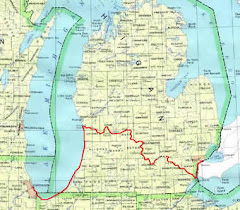Continuing from my 1999 article in "Michigan History" While struggling across the wetlands, the French party experienced an early April cold snap that brought trouble. According to LaSalle, "At last there came an unusually cold night on the second of April, and next day we were obliged to thaw our clothes before a fire in order to be able to use them, for they had become stiff as sticks because we had taken them off all soaked." The fire gave them away to the Mascouten war party that had been tracking them. LaSalle continued: "Our fire showed us to the Indians who had slept on the other end of the marsh, from which they ran with loud cries to about the middle, where there was a rather deep stream which they could not cross, because the ice that had formed during the night was not strong enough to bear them". When LaSalle wrote that the Mascoutens were "...at the other end of the marsh", that meant the Indians were ahead of them and across a stream that LaSalle's party had yet to cross. The description of a "rather deep stream" sounds like something bigger than the creeks they had been crossing. The stream must have been flowing across their easterly path in order for it to be a barrier to the charging Mascoutens. In this area, the Grand River flows from south to north, is bordered on both sides by marshes or swamps and is quite deep, especially when it floods. How did the Mascoutens, who had been tracking LaSalle for several days, end up ahead of him? There were two Indian trails that allowed the Indians to bypass LaSalle's party on either the north or south. The Mascouten's believed LaSalle's party was a band of Iroquois. What better spot to set an ambush than where the hunted ones would be struggling to cross a river in flood? LaSalle described his party's reaction when the Mascoutens charged and were stopped by the ice and river."We went to within gunshot of them; and either they were frightened by our position of advantage and our firearms, or believed there were more of us than there were, or else recognizing that we were Frenchmen, they did not wish to attack us". The two groups then palavered across the intervening water, the Indians saying they were "brothers" to the Frenchmen. The Mascoutens departed and LaSalle's party continued on their journey. On April 4 two of the Frenchmen became so ill that they could not walk farther. LaSalle does not describe the terrain traveled on April 3 and 4, but if the party continued in the same direction these two days there would have been more walking in marshes. Even today, there are extensive marshes between the Grand River and the highlands of northwest Washtenaw County, particularly the Portage Lake Swamp in the Waterloo State Recreation Area. After April 4 LaSalle gave no more dates until he arrived at Niagara on April 22. When the party reached the Huron River they built an elm-bark canoe. It is unclear when he found the Huron River, how long it took to build the canoe or when it was launched on the river. Nor does LaSalle's narrative offer any clue on how the two sick men got from the place where they became incapacitated to the site where the canoe was constructed. According to LaSalle, "I went to look for some stream which might fall into Lake Erie, where we wished to go, to make a canoe, so as to relieve those who were worn out with toil". This sounds as if he went ahead and left his companions and found the Huron River. LaSalle probably came to a well-used Indian trail adjacent to present-day Island Lake in Washtenaw County's Lyndon Township. At that juncture of time, place and circumstances he would have had no hesitancy in traveling on an Indian trail. It headed in the right direction and following it for eight or nine easy miles took him to the Huron River. Today this trail is Island Lake Road and it reaches Mill Creek near where the creek joins the Huron River at Dexter. NEXT: Building the canoe |

Wednesday, June 3, 2009
LaSalle's Walk on the Wild Side VIII
Subscribe to:
Post Comments (Atom)

No comments:
Post a Comment